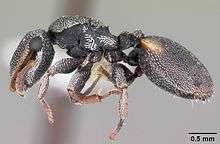Cephalotes texanus
Cephalotes texanus is a species of arboreal ant of the genus Cephalotes, characterized by an odd shaped head, and the ability to "parachute" by steering their fall if they drop off of the tree they're on. Giving their name also as gliding ants.[1][2] The species is native of Texas and of the Mexican states of Nuevo Leon, San Luis Potosí and Tamaulipas.[3] Their larger and flatter legs, a trait common with other members of the genus Cephalotes, gives them their gliding abilities.
| Cephalotes texanus | |
|---|---|
 | |
| Cephalotes texanus worker | |
| Scientific classification | |
| Kingdom: | |
| Phylum: | |
| Class: | |
| Order: | |
| Suborder: | |
| Family: | |
| Subfamily: | |
| Genus: | |
| Species: | C. texanus |
| Binomial name | |
| Cephalotes texanus Santschi, 1919 | |
The species was first given a description and a classification in 1919 by Swiss entomologist Felix Santschi.
Morphology
As some other members of its genus, Cephalotes texanus possesses an odd shaped head, which is the result of it adapting to nest in the nests of longhorn beetle larvaes, as their nests are already dug out by them, the species does not build nests. The odd shaped head of the species allows its soldier to deny access to the nest by blocking it with their head, further blocking themselves with a dorsal ridge on the dorsal part of their thorax. They have further evolved towards this purpose with their fragile antenaes being placed on the side of their heads, protected by the shield.
This form of morphological adaptation is called phragmosis.
References
- Latreille, P.A. (1802). Histoire naturelle, generale et particuliere des crustaces et des insectes. Vol. 3. F. Dufart, Paris. 467 pp. PDF
- Yanoviak, S. P.; Munk, Y.; Dudley, R. (2011). "Evolution and Ecology of Directed Aerial Descent in Arboreal Ants" (PDF). Integrative and Comparative Biology. 51 (6): 944–956. doi:10.1093/icb/icr006. PMID 21562023.
- "Species Range Maps". Antmaps.org. Retrieved 28 January 2019.
External links
